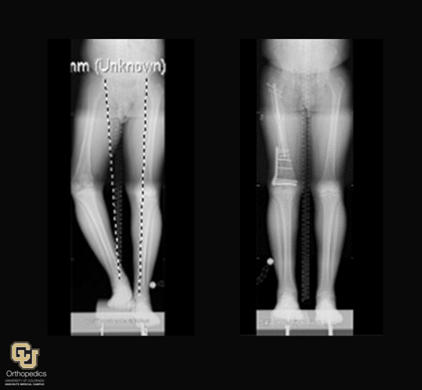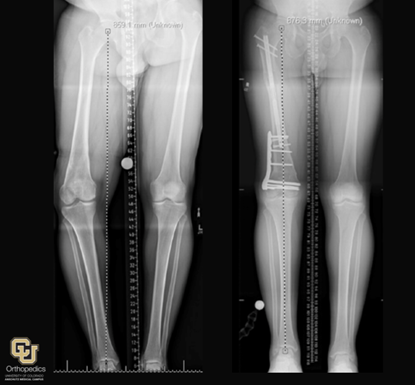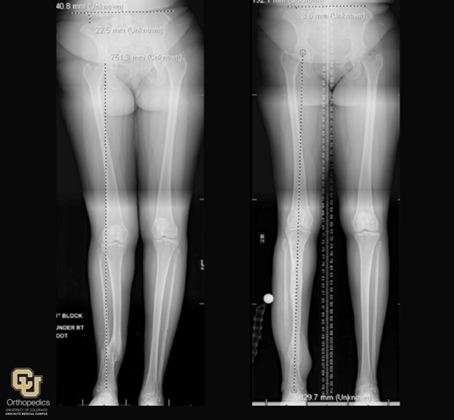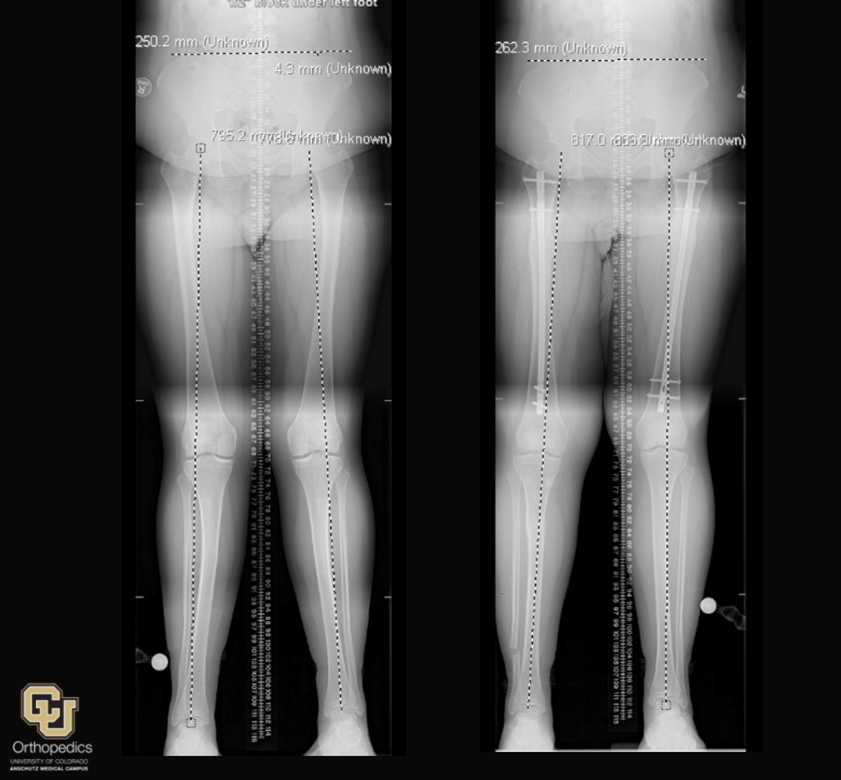University of Colorado, Limb Deformities, Knock Knees
Bone and Limb Deformities
What is a Limb Deformity?
A limb deformity is an arm or leg that is shaped abnormally. Limb deformities can occur at birth (congenital) or be caused later in life by an injury, tumor, medical condition, or infection. If the deformity is severe, the patient can experience pain, flat feet, clumsiness, or problems walking. Limb differences, or limb length discrepancies, are an example of a congenital limb deformity.
We treat many types of limb deformities at the University of Colorado. Common conditions include:
- Genu Varum: Bowleg Deformity
- Genu Valgus: Knock Knee Deformity
- Rotational Abnormalities: Femoral or tibial torsion, Miserable Malalignment.
What is Genu Varum or Bowleg Deformity?
Genu Varum, also known as bowleg or bowlegs, occurs when the knees stay apart or curve outwards when standing with the feet and ankles together. Common symptoms of genu varum include excessive falling, limping, tripping, pain, and concerns about the appearance of the legs. Bowleggedness can be caused by a number of conditions, including:
- Blount's disease
- Nutritional rickets and other metabolic bone diseases
- Skeletal dysplasia
- Infection
- Trauma and subsequent asymmetric growth
- Neoplasia
A diagnosis of Genu Varum can be made during an appointment with our University of Colorado Limb Restoration Program Team. Our team will perform a physical exam, take a detailed health history, and order x-ray imaging. X-rays may be taken from the hips to the feet of both legs, along with additional views to assess alignment further. Click here to contact our clinic to make an appointment.
If Genu Varum is left untreated, it may progress to osteoarthritis of the knee or ankle joints over time. Patients needing a total joint replacement due to osteoarthritis caused by Genu Varum may need to undergo deformity correction before the joint replacement can be completed.

This patient had a genu varus (bow leg) limb deformity of their right leg, shown in the x-ray on the left. It was corrected in two surgeries by Dr. Stoneback and his team, shown in the x-ray on the right.
How is Genu Varum or Bowleg Deformity Treated?
The way Genu Varum or Bowlegs is treated depends on the underlying cause. Typically, medical therapy for the primary disease is the first choice to treat bowlegs, if medical therapy is available. For example, our doctors may treat bowlegs caused by nutritional rickets by increasing Vitamin D and calcium intake. Orthotics (braces, splints, shoe inserts, etc.) are ineffective, and unnecessary, and may negatively impact a patient’s state of mind due to their lack of results.
Surgical therapy is reserved for patients with a residual deformity that cannot be treated by other medical therapies. Surgical deformity correction restores a patient’s proper alignment and ultimately improves the quality of life, strength, and longevity of knee and ankle joints. In some cases, it may delay or prevent joint replacement surgery.

This patient had a genu varus (bow leg) limb deformity of their right leg, shown in the x-ray on the left. It was corrected surgically by Dr. Stoneback and his team, as shown in the x-ray on the right.
What is Genu Valgus or Knock Knee Deformity?
Genu Valgus or Knock Knee Deformity occurs when a patient is standing with their toes forward, but their knees point inwards while their ankles stay apart. Common symptoms include difficulty running, flat feet, medial foot or knee pain, clumsiness, and concerns about the appearance of the legs.
Knock knees can be caused:
- Skeletal dysplasia
- Systemic or bone conditions such as rickets or renal osteodystrophy
- Improper post-traumatic injury healing
- Neoplasms
- Non-malignant (benign) lesions
Our team at the University of Colorado Limb Restoration Program can diagnose Genu Valgus by performing a thorough physical examination, taking a detailed medical history, and ordering x-ray imaging. Several views of the legs from the hips to the feet will be ordered to assess alignment fully. Click here to contact our clinic to make an appointment.
Like Genu Varus, if Genu Valgus is left untreated it may lead to osteoarthritis and potentially a total joint replacement of the knee or ankle. The patient needing a total joint replacement may have to undergo surgical correction of the knock knees first in order to have their joint replaced.

This patient underwent surgical correction for knock knees with Dr. Stoneback and the University of Colorado Limb Restoration Program.
How are Genu Valgus Deformities or Knock Knees Treated?
Similar to the treatment of Genu Varus, orthotics such as braces, splints, and shoe inserts are not effective treatments for knock knees. The underlying medical condition should be treated first if treatment options are available. If necessary, the patient may need to undergo corrective surgical therapy of the leg or legs experiencing the deformity. All of our patient’s treatment plans are designed to improve quality of life and reduction of pain while using the least invasive treatment options possible.
What is a Rotational Limb Deformity?
Rotational deformities (also known as rotational abnormality) occur when a leg bone or bones are turned or twisted inward or outward. For example, being pigeon-toed is an example of a rotational abnormality, as the position of the bones in the leg causes the foot or feet to be turned inwards (in-toeing). Other common rotational deformities include tibial torsion, femoral torsion, or miserable malalignment. Common symptoms of rotational abnormalities include pain in the hip, knee, or ankle, kneecap subluxation or dislocation, difficulty sitting in certain positions or crossing legs when sitting down, and difficulties participating in sports such as running, cycling, or skiing. Rotational deformities are caused by:
- A traumatic injury
- Congenital (occurs at birth)
Our team at the University of Colorado Limb Restoration Program can diagnose rotational abnormalities by performing a thorough physical examination, taking a detailed medical history, and possibly ordering imaging like x-rays. Several x-ray views of the legs from the hips to the feet may be needed to properly assess the bones’ alignments. Click here to contact our clinic to make an appointment.
Like Genu Varus and Genu Valgus, if a rotational abnormality is severe enough and is left untreated, the rotational abnormality may lead to osteoarthritis and potentially a total joint replacement of the knee or ankle. The patient needing a total joint replacement may have to undergo surgical correction of the rotational deformity first in order to have their joint replaced at a later date.

This patient had an inward rotational abnormality which caused them to become pigeon-toed (in-toed), as shown on left. The patient underwent corrective surgery with the CU Limb Restoration Program to correct their alignment, shown on right.
How are Rotational Abnormalities Treated?
Frequently, rotational deformities occur in the lower extremity and often affect both legs, unless the abnormal rotation was caused by an injury. Rotational deformities are fixed with surgery that aims to restore correct bone alignment. An osteotomy (cut into the bone) will be made, and surgical pins may be inserted to heal the bone correctly. The purpose of this surgery is to reduce pain and increase the patient’s quality of life.
Take the Next Step Towards Good Health
If you are experiencing a malunion, nonunion, or another condition that is affecting your limbs or has caused you limb loss, please contact our clinic to discuss your health.
Practice Location
CU Limb Restoration Program - University of Colorado Hospital
1635 Aurora Court Anschutz Outpatient Pavilion, 4th floor,Aurora, CO 80045
To make an appointment call:
Phone: 1-844-800-LIMB (5462)
Fax: 720-553-0402
E-Mail: [email protected]
For urgent or emergency transfers, call the Access Center at:
Phone: (720) 848-2828